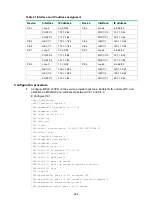
280
•
PE 1 and PE 2 are the provider carrier's PE routers. They provide VPN services for the
customer carrier.
•
CE 1 and CE 2 are the customer carrier's routers. They are connected to the provider carrier's
backbone as CE routers.
•
PE 3 and PE 4 are the customer carrier's PE routers. They provide MPLS L3VPN services for
the end customers.
•
CE 3 and CE 4 are customers of the customer carrier.
•
The customer carrier and the provider carrier reside in different ASs.
The key to carrier's carrier deployment is to configure exchange of two kinds of routes:
•
Exchange of the customer carrier's internal routes on the provider carrier's backbone.
•
Exchange of the end customers' VPN routes between PE 3 and PE 4, the PEs of the customer
carrier. In this process, an MP-EBGP peer relationship must be established between PE 3 and
PE 4.
Figure 78 Network diagram
Table 20 Interface and IP address assignment
Device
Interface
IP address
Device
Interface
IP address
CE 3
GE1/1/1
100.1.1.1/24
CE 4
GE1/1/1
120.1.1.1/24
PE 3
Loop0
1.1.1.9/32
PE 4
Loop0
6.6.6.9/32
GE1/1/1
100.1.1.2/24
GE1/1/1
120.1.1.2/24
POS1/1/1
10.1.1.1/24
POS1/1/1 20.1.1.2/24
CE 1
Loop0
2.2.2.9/32
CE 2
Loop0
5.5.5.9/32
POS1/1/0
10.1.1.2/24
POS1/1/0 21.1.1.2/24
POS1/1/1
11.1.1.1/24
POS1/1/1 20.1.1.1/24
PE 1
Loop0
3.3.3.9/32
PE 2
Loop0
4.4.4.9/32
POS1/1/0
11.1.1.2/24
POS1/1/0 30.1.1.2/24
POS1/1/1
30.1.1.1/24
POS1/1/1 21.1.1.1/24
















































